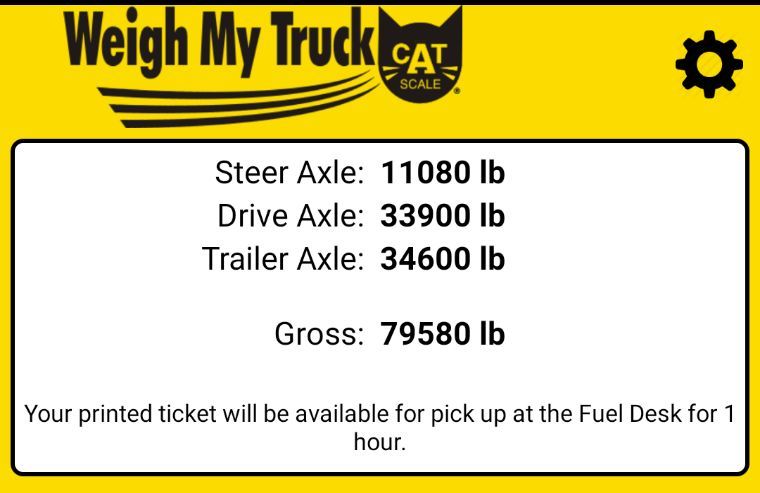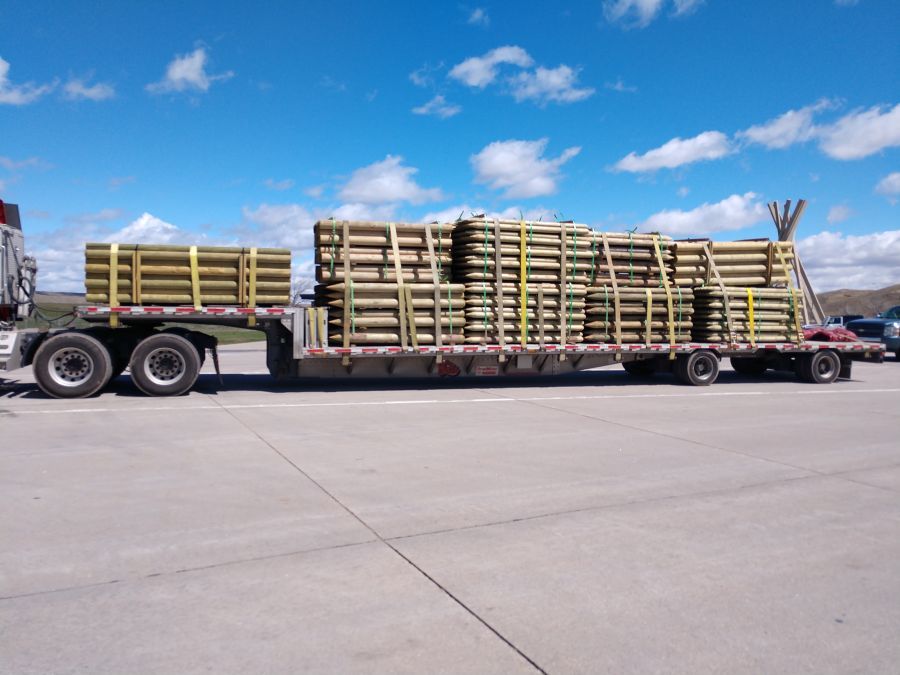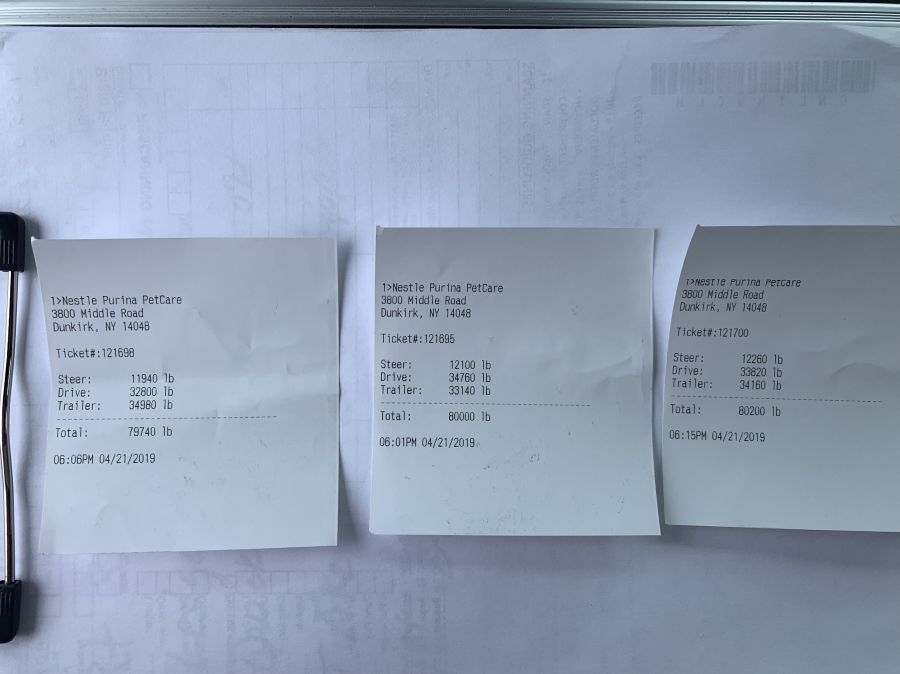Heaviest Weight You've Hauled?
Topic 22813 | Page 6

As close as I could get last night. I was hoping I didn’t pass a scale, or the guy would take pity on me.
Sealed load, no one in the plant to rework, closed for Easter.
That last adjustment was one hole.
Their scale is viral. At most one hole will move 500 pounds tops.
Take it to a certified CAT scale.
CAT Scale:
A network of over 1,500 certified truck scales across the U.S. and Canada found primarily at truck stops. CAT scales are by far the most trustworthy scales out there.
In fact, CAT Scale offers an unconditional Guarantee:
“If you get an overweight fine from the state after our scale showed your legal, we will immediately check our scale. If our scale is wrong, we will reimburse you for the fine. If our scale is correct, a representative of CAT Scale Company will appear in court with the driver as a witness”
Yeah, you definitely have to lower the gear. I had to really crank it to get the weight off. It was hard, but like Brett said, it isn't common. The reason I had to do it was because I was in the normal third set of holes, but my steers weighed in the 11's with full tanks. I was good on my tandems , but my drives were way over. I shifted some to the steers(company told me I could go up to 12.5) and equaled out the drives and tandems finally. It was a pain.
Tandems:
Tandem Axles
A set of axles spaced close together, legally defined as more than 40 and less than 96 inches apart by the USDOT. Drivers tend to refer to the tandem axles on their trailer as just "tandems". You might hear a driver say, "I'm 400 pounds overweight on my tandems", referring to his trailer tandems, not his tractor tandems. Tractor tandems are generally just referred to as "drives" which is short for "drive axles".
Tandem:
Tandem Axles
A set of axles spaced close together, legally defined as more than 40 and less than 96 inches apart by the USDOT. Drivers tend to refer to the tandem axles on their trailer as just "tandems". You might hear a driver say, "I'm 400 pounds overweight on my tandems", referring to his trailer tandems, not his tractor tandems. Tractor tandems are generally just referred to as "drives" which is short for "drive axles".
I think the exact terminology is : “turn it either just south of enough or just north of enough “
I posted this load in flatbed variety. These were my weights. I was in between 3/8 and a 1/2 tank. I ended up putting 60 gallons in the tank, about 40 miles from my delivery, as my 1/8 tank light came on shortly before that. I filled her up, after I delivered. I keep my 5th wheel all the way back.


I keep my 5th wheel all the way back
Your 5th wheel is at least 2 holes too far back, depending on the hole spacing.
Hitachi EX400 92,400 lbs not including the truck and trailer.
I don’t scale out.
Hitachi EX400 92,400 lbs not including the truck and trailer.
I don’t scale out.
You heavy haulers live in a world of your own!


I keep my 5th wheel all the way back
Your 5th wheel is at least 2 holes too far back, depending on the hole spacing.
Our company asks us is to keep it at 11,800 lbs or less if possible. My steers were at 2300lbs, When I slid them back.
Aside from this load, I have not had any issues with my weight balance, since I slid the 5th wheel back. They had to remove a bundle, too.
I underestimated how the extra little bit of length, effected my off tracking, too. Just glad I didn't hit anything.
My steers were at 2300lbs, When I slid them back.
2300 lbs? I believe that is a typo!
New Reply:
New! Check out our help videos for a better understanding of our forum features

















Preview:
This topic has the following tags:
Adverse Conditions DOT Life On The Road Safe Driving Tips Truck Driving Lifestyle Understanding The Laws Weight and Scales








 TT On Facebook
TT On Facebook
It's important to understand that you should never have to slide your fifth wheel if it's in the right spot. In fact, there are quite a few tractors on the road that don't even have a sliding 5th wheel. I slid my 5th wheel exactly one time in 15 years right after I was assigned a new tractor and it wasn't in the right spot. The first real heavy load I was assigned with that tractor had the steer tires at like 11,600 so I slid it forward one hole. That put the steers at 12,100 with a 79,000+ gross and the tandems and drives pretty evenly matched. I never touched it again after that, or moved it on any other tractor I had.
When you get a real heavy load the steers should be right at or just above 12,000 with the tandems and drives pretty evenly matched. Then you know the 5th wheel is in the right spot and you should never touch it after that. Most of the weight of your fuel will go on the steers, so the exact weight on those steers with a heavy load will vary based on the fuel you have.
Tandems:
Tandem Axles
A set of axles spaced close together, legally defined as more than 40 and less than 96 inches apart by the USDOT. Drivers tend to refer to the tandem axles on their trailer as just "tandems". You might hear a driver say, "I'm 400 pounds overweight on my tandems", referring to his trailer tandems, not his tractor tandems. Tractor tandems are generally just referred to as "drives" which is short for "drive axles".
Tandem:
Tandem Axles
A set of axles spaced close together, legally defined as more than 40 and less than 96 inches apart by the USDOT. Drivers tend to refer to the tandem axles on their trailer as just "tandems". You might hear a driver say, "I'm 400 pounds overweight on my tandems", referring to his trailer tandems, not his tractor tandems. Tractor tandems are generally just referred to as "drives" which is short for "drive axles".
HOS:
Hours Of Service
HOS refers to the logbook hours of service regulations.